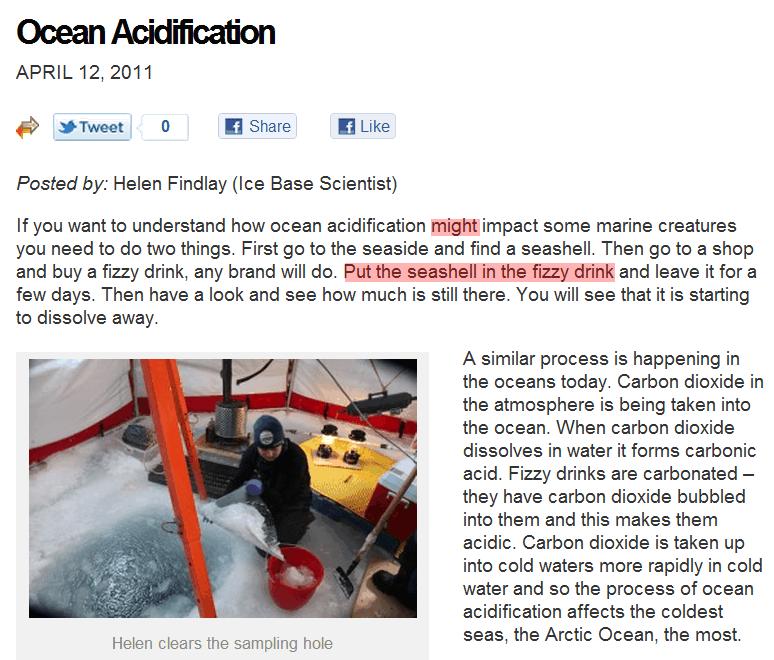Junk science taken to new heights by the frozen campers. The ocean has a pH of 8. Soft drinks have a pH of 3, one hundred thousand times more acidic than seawater. In industry, this would be called fraud.
http://www.catlinarcticsurvey.com/2011/04/12/ocean-acidification/



Fizzy drinks acidity is due to the stronger mineral acid, phosphoric acid. This is usually buffered to pH 4-5 to give mostly sodium hydrogen phosphate-sodium dihydrogen phosphate buffer in solution. The CO2 at this acidity is mostly free form.
I liked pouring Coke on the rust on my bike rims when I was a kid. It amazed my sister too.
“A similar process is happening in the oceans today.”
———-
Put one foot into hot embers and another into a bucket of ice – you’ll feel about average.
Put an egg into a saucepan of plain tap water and set aside. Put another egg into saucepan of boiling water and wait 3 minutes. When ready crack open both eggs and compare. ;O)
Dammit! Why don’t they teach science anymore?……… NVM, the Catlin team tells me why……… bastards.
When I was a boy, if you bubbled CO2 through limewater CaCO3 precipitated out. The oceans are still closer to limewater than to carbonic acid, and the extra CO2 provides the carbon, which is the limiting factor for shell growth.
Why not say place a shell into a cup of sea water and another into tap water and leave for a few days. Results – zilch.
Errrrr. . . calcium carbonate is more soluble in cold water than warm, which is why coral reefs only occur in warmer waters. AND the phosphoric acid or citric acid (etc.) in many drinks, put in the mix to keep the drink fizzy, pushed to form carbonic acid, would be an outside source of H+ to dissolve some calcium carbonate.
The Caitlin crew are suffering from the dumbness brought on by hypothermia?
Or did they start out this impaired?
Then again, I believe their science background to be the minimum needed to graduate from lower school. I might be over-estimating, though.
So a simplified version of the reaction they’re showing with the soda is:
2H+ + CaCO3 -> Ca++ + H2CO3
Okay, that works. But the supposed ocean acidification is adding H2CO3 to the solution…it’s in the product side…so what’s going to happen to the equilibrium? Anyone want to guess (I know it’s more complicated than given above, but adding carbonic acid is quite a bit different than adding another similar acidic compound, such as MES)?
Also, I haven’t seen kinetic data for CO2 uptake, but somehow I doubt that it’s much faster (if faster at all) when cold compared to warm. Thermodynamically, yes, CO2 is less soluble in warm water. But they’re making an argument from rates, and I wouldn’t be convinced of that at all.
-Scott
I’m actually more interested in the effects of hydrothermal vents, this one’s from 1998, so it’s not exactly new. http://www.ted.com/talks/david_gallo_on_life_in_the_deep_oceans.html
On the video at about 5:30, he states the temp of the vents water entering the ocean at about 600F – 700F, that’s got to have an effect on ocean heat content.
And it’s spewing hydrogen sulfide, or as he says about about the 10:50 mark, “this stuff is toxic as hell by the way… basically it’s sulfuric acid…”
What effect does that have on ocean PH, I believe sulfuric acid PH is about 1, well down there on the acid side of things.
Since polar bears are/were used as advertising mascots for Coke, I’d like to see them put one of those in a container of coke just to see what happens.
And if the bear doesn’t kill them all the first time, the scientific method would require repeating the experiment. And they are real scientists, right?